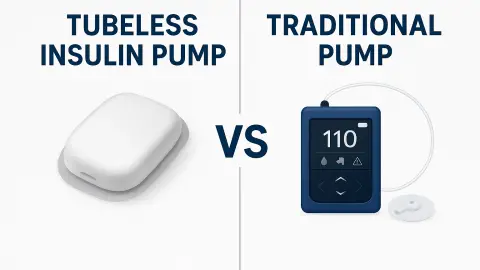Living with diabetes means paying close attention to every part of your body—especially your feet. For people with diabetic neuropathy, finding the best shoes for diabetics isn’t just about comfort—it’s about protection, stability, and preventing serious complications. Foot injuries that might seem minor can lead to infections or ulcers that heal slowly, so the right footwear is essential.
This guide explains what makes a shoe diabetic-friendly, how neuropathy affects your feet, and which features to look for when choosing your next pair. You’ll also find expert recommendations, care tips, and answers to the most common questions about footwear for diabetic neuropathy.
Understanding Diabetic Neuropathy
What Is Diabetic Neuropathy?
Diabetic neuropathy is a form of nerve damage caused by prolonged high blood sugar levels. It most commonly affects the feet and legs, leading to numbness, tingling, burning sensations, and loss of sensation. Because of this, people with neuropathy may not feel pain or injury in their feet, increasing the risk of wounds or ulcers.
Over time, untreated neuropathy can cause muscle weakness and changes in foot shape, making it even more important to wear specialized diabetic shoes that provide adequate support and protection.
Why Footwear Matters So Much
For those with neuropathy, a poorly fitting shoe can cause friction, blisters, or pressure points that may go unnoticed. These small issues can turn into open sores or infections. The best shoes for diabetics are designed to minimize these risks through soft interiors, wider toe boxes, extra cushioning, and seamless designs.
Proper footwear not only supports mobility but also plays a vital role in preventing long-term complications such as ulcers or amputations.
Key Features of the Best Shoes for Diabetics with Neuropathy
1. Wide Toe Box
A wide toe box gives your toes space to move naturally without rubbing or overlapping. This reduces pressure and prevents irritation, especially for those with hammertoes, bunions, or swelling.
2. Seamless Interior
Internal seams can create friction, which is dangerous for numb feet. Seamless interiors help eliminate the risk of blisters or sores caused by rubbing.
3. Extra Depth
Shoes with extra depth accommodate orthotics or diabetic insoles, which provide additional cushioning and support. This feature also prevents tightness across the top of the foot.
4. Soft, Breathable Materials
Materials like leather or mesh allow airflow and reduce moisture buildup—an essential factor for avoiding fungal infections.
5. Cushioned Insoles and Shock Absorption
Since people with neuropathy may not sense impact properly, shock-absorbing soles reduce strain on joints and prevent injuries from uneven surfaces.
6. Non-Slip Outsoles
A non-slip outsole provides stability and reduces the risk of falls, which can be especially dangerous for people with balance issues caused by neuropathy.
The 10 Best Shoes for Diabetics with Neuropathy (2025 Edition)

1. Orthofeet Coral Stretch Knit Sneakers (Women)
These shoes are among the top-rated choices for diabetic neuropathy. The stretchable upper adapts to foot shape changes, while the orthotic insole provides anatomical arch support. The padded heel and non-binding design help prevent friction and pressure.
Women love the Coral model for its lightweight feel, stylish look, and relief from burning or tingling sensations. They’re ideal for all-day wear, from casual outings to light exercise.
2. Orthofeet Edgewater Sneakers (Men)
The Edgewater sneakers combine comfort with medical-grade protection. Their ergonomic soles and gel-padded heel help absorb shock and reduce foot fatigue. They also come with a wide toe box, which is perfect for swollen or sensitive feet.
Men with neuropathy appreciate the shoe’s seamless interior and ability to accommodate custom orthotics.
3. Dr. Comfort Wing Men’s Dress Shoe
If you need formal footwear that doesn’t compromise foot health, the Dr. Comfort Wing is a smart choice. These dress shoes are made from soft leather, with extra depth and removable insoles for orthotics.
They maintain a professional look while ensuring that your feet stay protected during long work hours or special events.
4. Propét Stability Walker (Men & Women)
The Propét Stability Walker offers exceptional support with its firm heel counter, durable rubber sole, and cushioned footbed. It’s an excellent all-around walking shoe for diabetics with neuropathy who want stability and comfort.
Its full-grain leather upper and wide toe box make it ideal for daily walking, errands, or light exercise.
5. New Balance 990v6
New Balance consistently produces shoes designed for comfort and medical needs. The 990v6 model provides strong arch support and a firm midsole that enhances balance. The breathable mesh helps keep feet dry, while the extra depth allows for inserts.
It’s also a great choice for those with mild neuropathy who want an active lifestyle.
6. Skechers Go Walk Arch Fit
Skechers’ Go Walk Arch Fit line is recommended by podiatrists for its certified arch support. The shoe molds to your foot, providing personalized cushioning that relieves pressure points. The stretch upper makes it easy to slip on and off, reducing strain.
This model is lightweight and flexible, ideal for neuropathy patients seeking comfort and mobility.
7. Hush Puppies Power Walker
The Hush Puppies Power Walker offers an ideal combination of style and support. Its BioBevel heel technology enhances foot movement and stability, while the soft padded collar prevents ankle irritation.
For diabetics who want an everyday walking shoe that doesn’t look “medical,” this is an excellent option.
8. Apex Balance Walking Shoe
This shoe is built with balance and fall prevention in mind. The Apex Balance model includes a firm heel counter, wide base, and slip-resistant outsole—all crucial for neuropathy-related instability.
It also offers removable depth layers, so you can adjust the cushioning to your comfort level or use custom inserts.
9. Dr. Comfort Therapeutic Mary Jane (Women)
This shoe is designed for diabetic women who want a balance between comfort and style. The adjustable strap makes it easy to get the perfect fit, while the protective toe box prevents friction and pressure.
The Mary Jane design makes it suitable for casual or dress occasions, while still offering diabetic-grade protection.
10. Brooks Addiction Walker 2
The Brooks Addiction Walker 2 is another highly recommended choice for those with neuropathy. Its extended progressive diagonal rollbar supports natural motion and reduces stress on joints. The leather upper adds durability and the cushioned midsole provides consistent comfort.
This model works well for long walks, daily errands, and extended wear.
How to Choose the Right Diabetic Shoe for Your Needs
Step 1: Measure Your Feet Regularly
Neuropathy can cause changes in foot shape or swelling, so it’s important to measure your feet every 6 to 12 months. Choose shoes that allow enough space for your toes and don’t pinch anywhere.
Step 2: Try Shoes at the End of the Day
Feet tend to swell as the day progresses. Trying shoes in the evening ensures they’ll fit comfortably all day long.
Step 3: Check for Pressure Points
Before purchasing, wear the shoes for several minutes and check for any tight spots or friction. You should feel secure but not squeezed.
Step 4: Prioritize Function Over Fashion
While aesthetics matter, foot protection should come first. Choose shoes designed for diabetic use—even if they look simple—because they prevent injury and discomfort better than standard shoes.
Step 5: Replace Shoes Regularly
Worn-out shoes lose their cushioning and support. Replace your diabetic shoes every 6–12 months, depending on how frequently you wear them.
Caring for Your Feet When You Have Neuropathy
1. Inspect Your Feet Daily
Use a mirror or ask a family member to help check for blisters, cuts, redness, or swelling. Early detection can prevent infections and ulcers.
2. Wash and Moisturize
Clean your feet daily with warm (not hot) water and mild soap. Dry them gently, especially between the toes, and use a non-greasy moisturizer to keep your skin soft.
3. Avoid Walking Barefoot
Always wear shoes or slippers to prevent accidental cuts or burns. Even minor injuries can become serious for those with neuropathy.
4. Trim Nails Carefully
Trim nails straight across and file sharp edges. If you have difficulty doing this safely, visit a podiatrist.
5. Visit a Podiatrist Regularly
Routine check-ups with a foot care specialist help identify early signs of complications and ensure your footwear fits correctly.
Benefits of Wearing Diabetic-Friendly Shoes
- Reduced Risk of Ulcers and Infections: Proper cushioning and seamless interiors prevent blisters and sores.
- Improved Balance and Stability: Non-slip soles and arch support help prevent falls.
- Better Circulation: Roomier designs prevent constriction and allow blood to flow more freely.
- Pain Relief: Cushioning helps reduce discomfort from pressure points and neuropathic pain.
- Enhanced Mobility: Comfort and support encourage walking, improving overall circulation and fitness.
Mistakes to Avoid When Buying Shoes for Neuropathy
- Choosing the wrong size (too tight or too loose)
- Ignoring width and depth
- Buying shoes with internal seams or stiff materials
- Skipping orthotics or diabetic insoles
- Failing to replace worn shoes
- Focusing only on appearance rather than protection
Each of these mistakes can lead to discomfort, injury, or long-term complications. Always prioritize fit, comfort, and medical-grade features.
Best Insoles for Diabetic Neuropathy
Insoles can make a huge difference, even in the best shoes. Look for orthotic insoles with the following features:
- Extra cushioning in the heel and ball of the foot
- Arch support for stability
- Pressure redistribution to prevent ulcers
- Breathable, antimicrobial materials
Top-rated insoles include Dr. Scholl’s Diabetes Foot Pain Relief Orthotics, Orthofeet BioSole-Gel Inserts, and Powerstep Pinnacle Maxx.
When to See a Doctor About Foot Pain
If you experience persistent burning, numbness, or changes in foot shape, consult a doctor or podiatrist. They can check for circulation issues, infection, or advanced neuropathy.
Prompt medical attention is key to preventing complications such as ulcers or gangrene. Even if your shoes are comfortable, professional foot evaluations are essential for long-term health.
FAQs About Shoes for Diabetics with Neuropathy
Can I Wear Regular Shoes If I Have Neuropathy?
It’s possible, but not recommended. Regular shoes often lack the protection and support diabetic feet need. Always look for models labeled “diabetic-friendly” or consult your podiatrist.
Are Memory Foam Shoes Good for Neuropathy?
Yes, memory foam provides cushioning and pressure relief. However, ensure the shoe also offers arch support and a wide toe box.
How Often Should I Replace Diabetic Shoes?
On average, replace them every 6 to 12 months, depending on wear and tear. If you notice loss of cushioning or structure, it’s time for a new pair.
Should I Wear Socks with Diabetic Shoes?
Absolutely. Choose moisture-wicking diabetic socks with no seams to prevent irritation and maintain dry, healthy skin.
Can Diabetic Shoes Be Covered by Insurance?
Yes, many insurance plans and Medicare cover one pair of diabetic shoes per year if prescribed by a doctor.
Final Thoughts
Finding the best shoes for diabetics with neuropathy isn’t about luxury—it’s about maintaining your mobility and protecting your health. The right footwear minimizes pressure points, prevents ulcers, and offers long-term comfort that standard shoes simply can’t provide.
Whether you prefer athletic sneakers, walking shoes, or formal footwear, make sure they include essential diabetic-friendly features: wide toe boxes, cushioned soles, breathable materials, and seamless interiors. Always consult with a podiatrist before making your final choice.
Your feet deserve the best protection possible—because when you take care of them, you’re also taking care of your overall well-being.


